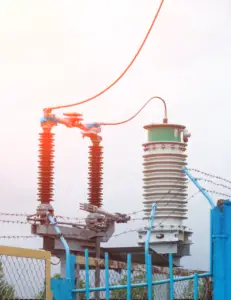Why arcing occurs while operating isolators even the circuit breaker is open?
A common phenomenon observed during the operation of high voltage transmission devices is the occurrence of small arcs, mainly while operating devices like isolators. Here we briefly discuss why it occurs even when the circuit breaker is open.

The Phenomenon of Arcing
Arcing is a phenomenon that occurs when electricity, in attempting to bridge the gap between two conductive materials (in this case, the contacts of the isolator or circuit breaker), ionizes the air or gas in the gap and forms a conductive plasma, known as an electric arc.
In transmission lines due to their very high voltage values, the air in the gap can become ionized, creating a path of the least resistance for the current to continue flowing, resulting in a small arc.
The role of Isolators and Circuit Breakers
Circuit breakers are designed to protect the electrical circuit from damage caused by excess current from an overload or short circuit. They do this by interrupting the current flow once a fault is detected. They can also be used to manually open and close a circuit.
Isolators, on the other hand, are switchgear devices used to ensure that a circuit is completely de-energized for service or maintenance. They provide a visible point of isolation that assures personnel of a break in the circuit, enhancing safety during maintenance operations. Isolators are operated under no load condition, circuit breakers are used to open the circuit before opening isolator, and isolator is closed before closing the breaker.
Why arcing occurs even when the Circuit Breaker is Open?
The occurrence of arcing while operating isolators, even when the circuit breaker is open, can be attributed to several factors:
- Residual Current: Even after a circuit breaker has been opened, there may still be residual current in the system due to inductive or capacitive effects. This residual current can cause a small arc across the contacts.
- Current interruption challenges: Circuit breakers are designed to interrupt current flow, but they can’t do it instantaneously. Especially with inductive loads (like motors), the collapsing magnetic field induces a high voltage that can try to maintain current flow across the gap as an arc.
- Switching Transients: Rapid changes in current or voltage, known as switching transients, can occur when a circuit breaker or isolator is operated. These transients can cause a momentary arc across the contacts.
- Ionized path: When the circuit breaker trips, the contacts separate rapidly. However, the air gap between them can become ionized due to the intense heat and leftover current. This ionized air acts like a conductor, allowing current to momentarily “jump” the gap as an arc until it extinguishes.
- Deteriorated breaker contacts: Over time, arcing during normal operation can wear down the contacts in a circuit breaker. Pitting and erosion can increase the gap distance and make it harder to fully extinguish the arc when the breaker trips under fault conditions.
- High voltage situations: In high voltage systems, even a small gap can be bridged by an arc due to the stronger electrical field. Circuit breakers for these applications have special arc quenching mechanisms to extinguish the arc more effectively.
- Short circuit currents: Extremely high currents from a short circuit can overwhelm the arc quenching abilities of a breaker, leading to a sustained arc even after the contacts are open. This highlights the importance of properly sized circuit breakers for the potential fault current in a circuit.
The isolator operations are done quickly so that the arc doesn’t persist for long. Arcing ceases during the opening of isolators when a sufficient air gap forms between the conductors, breaking the conductive path. Conversely, arcing is absent during closing when the isolator contacts fully close, eliminating any air gap between the conductors.